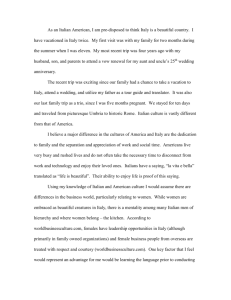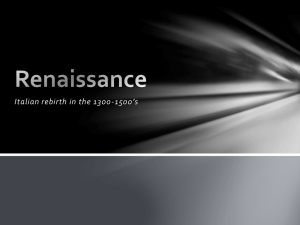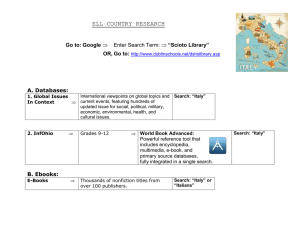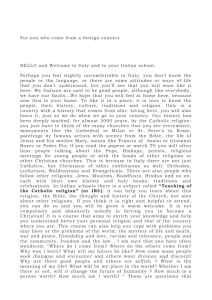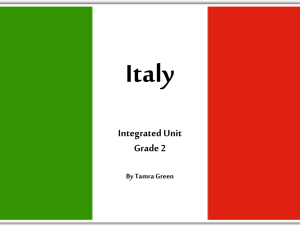9389 HISTORY MARK SCHEME for the May/June 2015 series
advertisement
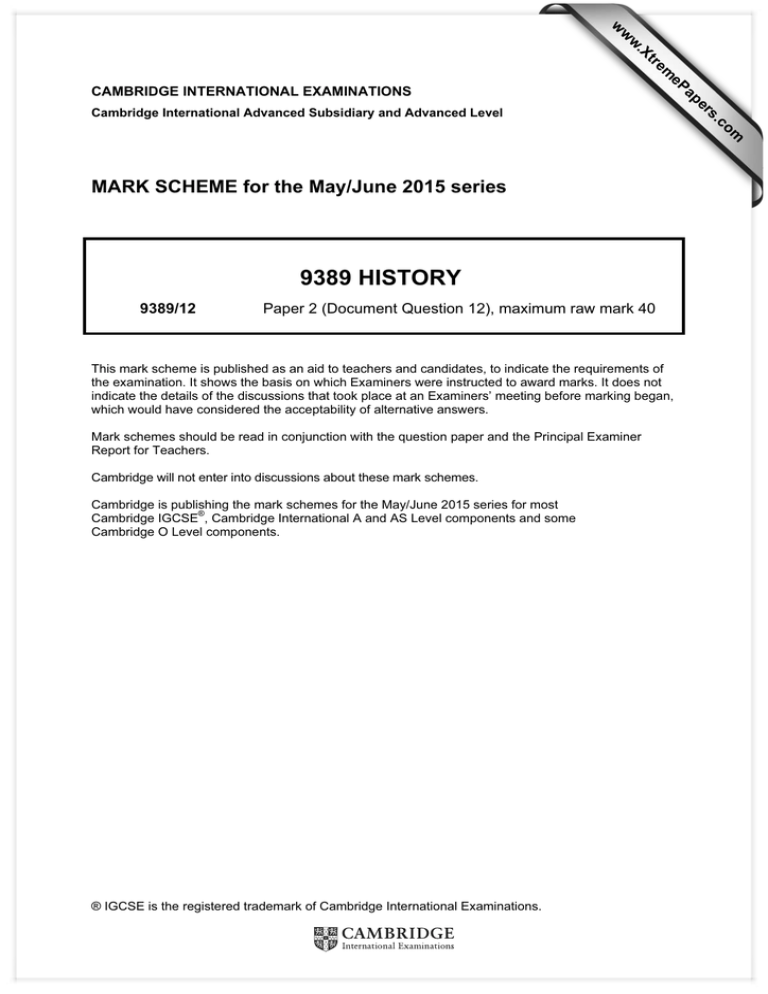
w w ap eP m e tr .X w CAMBRIDGE INTERNATIONAL EXAMINATIONS om .c s er Cambridge International Advanced Subsidiary and Advanced Level MARK SCHEME for the May/June 2015 series 9389 HISTORY 9389/12 Paper 2 (Document Question 12), maximum raw mark 40 This mark scheme is published as an aid to teachers and candidates, to indicate the requirements of the examination. It shows the basis on which Examiners were instructed to award marks. It does not indicate the details of the discussions that took place at an Examiners’ meeting before marking began, which would have considered the acceptability of alternative answers. Mark schemes should be read in conjunction with the question paper and the Principal Examiner Report for Teachers. Cambridge will not enter into discussions about these mark schemes. Cambridge is publishing the mark schemes for the May/June 2015 series for most Cambridge IGCSE®, Cambridge International A and AS Level components and some Cambridge O Level components. ® IGCSE is the registered trademark of Cambridge International Examinations. Page 2 Mark Scheme Cambridge International AS/A Level – May/June 2015 Syllabus 9389 Paper 12 Generic levels of response Part (a) Level 4: Makes a developed comparison [12–15] Makes a developed comparison between the two sources, recognising points of similarity and difference. Uses knowledge to evaluate the sources and shows good contextual awareness. Level 3: Compares views and identifies similarities and differences [8–11] Compares the views expressed in the sources, identifying differences and similarities. Begins to explain and evaluate the views using the sources and knowledge. Level 2: Compares views and identifies similarities and/or differences [4–7] Identifies relevant similarities or differences between views/sources and the response may be onesided with only one aspect explained. Alternatively, both similarities and differences may be mentioned but both aspects lack development. Level 1: Describes content of each source [1–3] Describes or paraphrases the content of the two sources. Very simple comparisons may be made (e.g. one is from a letter and the other is from a speech) but these are not developed. Level 0: No relevant comment on the sources or the issue [0] Part (b) Level 5: Evaluates the sources to reach a sustained judgement [21–25] Answers are well focused, demonstrating a clear understanding of the sources and the question. Reaches a sustained judgement about the extent to which the sources support the statement and weighs the evidence in order to do this. Level 4: Evaluates the sources [16–20] Demonstrates a clear understanding of the sources and the question. Begins to evaluate the material in context, considering the nature, origin and purpose of the sources in relation to the statement. At the top of this level candidates may begin to reach a judgement but this is not sustained. Level 3: Uses the sources to support and challenge the statement [11–15] Makes valid points from the sources to both challenge and support the statement in the question. These comments may be derived from source content or may be about the provenance/nature of the sources. Level 2: Uses the sources to support or challenge the statement [6–10] Makes valid points from the sources to either support the statement in the question or to challenge it. These comments may be derived from source content or may be about the provenance/nature of the sources. Level 1: Does not make valid use of the sources [1–5] Describes the content of the sources with little attempt to link the material to the question. Alternatively, candidates may write an essay about the question without reference to the sources. Level 0: No relevant comment on the sources or the issue © Cambridge International Examinations 2015 [0] Page 3 Mark Scheme Cambridge International AS/A Level – May/June 2015 Syllabus 9389 Paper 12 Section A: European Option Liberalism and Nationalism in Italy and Germany, 1848–1871 Problems facing Italian nationalism Indicative content (a) To what extent do Sources A and B agree about the principal problems facing those who wished for a united Italy? [15] Both sources reflect on the state of Italy following the end of the Napoleonic wars and the outcomes of the Congress of Vienna in 1815. Source A, a private dispatch from the Piedmontese ambassador, comments on the various states which between them rule Italy. He is critical of Naples and the Papacy and surprisingly realistic about the situation of his own state, Piedmont. He bemoans foreign intervention in Italy as well as the excessive power of the Papacy. Source B, a journal (and thus private) of a French author, written the year before, goes further in his critical comments on the various states of Italy – and Austria as well. Source A says more about Piedmont, which is no surprise. Both are critical of the Pope’s rule over the Papal States. Source A writes more from the perspective of Italy, focusing more on its vulnerability to attack by external powers. Source B is just rude about most Italian states and especially the influence of the Catholic Church. Source A is more measured in its language while its descriptions are less lurid than Source B’s. Source B is too emotional to be reliable, while Source A would have been written to gain the support of Russia – presumably against Austria – which is a bit odd because in 1818 Austria and Russia were close allies in the reactionary Holy Alliance. Thus neither source is really trustworthy. (b) ‘The main obstacle to Italian unification was Austria.’ How far do Sources A to D support this view? [25] Context: The 1815 Treaty of Vienna had increased Austrian presence in Italy when it formally gained Lombardy-Venetia, mainly to contain revolutionary threats across the peninsula. The rulers of the various Italian states accepted this great power presence as they were not too keen on revolution either. The dominance of the Papacy, religious across Italy, secular within the Papal States, reinforced the forces of conservatism. Italian nationalists were rarely seen or heard. Reaction and repression ruled. The idea of a united Italy had very few supporters. There was no Italian equivalent of the German Confederation set up by the Congress of Vienna. The late 1810s were a time of triumph for the forces of conservatism, a time of defeat for liberalism and nationalism. The system of control and repression established by Metternich was at its most powerful. Minor revolts occurred a few years later, in 1820–21, when the Carbonari inspired revolts in various states across Italy. They were easily defeated, thanks to their own weaknesses and the strength of the Austrian forces. Italian nationalist movements did emerge by 1830–31, when Mazzini established Young Italy with the aim of establishing a united Italian republic by means of popular revolution. They had little success. More realistic politicians sympathetic to gradual change began to emerge in the 1840s, most notably the Piedmontese politician, Cavour. © Cambridge International Examinations 2015 Page 4 Mark Scheme Cambridge International AS/A Level – May/June 2015 Syllabus 9389 Paper 12 Analysis: None of the sources list Austria as the main obstacle to unification. Source B makes no direct reference to unification and little to Austria. It focuses on the differences between the states of Italy. Austria is stated as treating Italy as a colony to exploit, which suggests dominance in its own economic interests rather than control for political reasons. The main obstacle to the unification of Italy according to Source B is the disunity of the states of Italy. Source A says much the same, referring to the rich and fertile lands controlled by Austria, though it also gives some support for Austria exercising a degree of political supremacy, at least in the north of Italy. The only mention of Austria made by Source C is very indirect, very implicit as Mazzini talks of Italian monarchs having to make concessions to foreign courts, the most obvious of which would be the Habsburg Empire. Source D does not make even an indirect reference to Austria. He blames the failure to unify Italy on the idealism of the revolutionaries and the power of the ruling classes. These sources need evaluating against contextual knowledge. Evaluation: Two of these sources, A and D, come from the Piedmontese ruling class, the first from a diplomat, the second from a politician. The first had reasons of state for omitting any consideration of Austria in Italy. In 1818, a Piedmontese official would know full well that Russia and Austria, Alexander I and Metternich, were close partners in an anti-nationalist alliance. The diplomat states his preference for a strong state in northern Italy, by which he must mean an expanded Piedmont, which can only be at Austria’s expense. Presumably, he is hoping that Alexander I and Russia can contain Metternich’s inevitable opposition to such plans. This makes Source A less reliable than it seems. Source D is from Cavour, the later architect of Italian unification, though here writing before the start of his political career. He too had his reasons for not mentioning Austria. Probably writing for an Italian audience, Cavour wanted his readers to reflect on the realities of power within Italy, on how Italians were themselves responsible for the failures of the revolutions of 1820–21 and 1830. He was trying to educate literate, middle class Italians because they would provide the power behind future political change that he saw as necessary. Source C is from another powerhouse of Italian unification, Mazzini. This source is probably part of the statement establishing Young Italy, the organisation set up to establish a united Italy. Believing that Italians were responsible for their own fate, Mazzini gave little time to consideration of Austria. As with Cavour in Source D, he was trying to inspire Italians to action, albeit in a more revolutionary way. The outlier is Source B in that (a) it is written by a Frenchman, and (b) it is for the writer’s own use. The source, full of derogatory comments about Italian states, is most unreliable. However, it is useful in giving an outsider’s view of a peninsula and a people prone to quarrel and to argue. The sources provide some fascinating contrasts of opinion about Italian nationalism between 1815 and 1848. That they never properly address the reality of Austrian power shows their unreality. Cavour, however, was to come face to face with that power in the 1850s, when he had to turn to France to help evict Austria and establish that strong state in northern Italy proposed by the Piedmontese diplomat some forty years earlier. © Cambridge International Examinations 2015 Page 5 Mark Scheme Cambridge International AS/A Level – May/June 2015 Syllabus 9389 Paper 12 Section B: American Option The Origins of the Civil War, 1846–1861 The Caning of Senator Sumner in 1856 Indicative Content (a) Compare and contrast the responses of the states of South Carolina and Massachusetts in Sources C and D to news of the caning of Senator Sumner in May 1856. [15] According to the South Carolinian, Source C, the news that Preston Brooks had caned Senator Sumner was welcomed by the people of South Carolina, both freemen and slaves, white and black. At a time when politics was for men only, even the women of South Carolina gave Brooks their support. The support of some slaves comes as a real surprise. It is very doubtful that their support was freely given. The Boston Post, Source D, might be expected to be as critical of the beating of Sumner as Source C had been supportive. The response, however, is more nuanced. The Post identifies the very strong response of critics of slavery such as the Rev. Mr Kirk, who reportedly argued that people such as Preston Brooks would be swept aside in the coming civil war. This group of abolitionists thus responded to the news with very dramatic, apocalyptic language. The Boston Post reports this view in order to criticise it as coming from ‘a fanatical brood’ and being unrepresentative of the ‘solid men of Massachusetts’. (b) How far do Sources A to D support the view that the caning of Senator Sumner was a disaster for the South? [25] Context: Representative Preston Brooks caned Senator Sumner in the chamber of the US Senate because two days previously Sumner had made a very strong personal attack on Brooks’ uncle, Senator Butler of South Carolina, even alluding to a mild physical disability he had. This had come at the end of a very long and very emotional speech entitled ‘The Crime against Kansas’ which blamed the Kansas-Nebraska Act and its two authors for the problems in Kansas. The authors were Senators Douglas and Butler. Brooks thought the speech to be a crime against the honour of both Butler and South Carolina. While Sumner was working at his desk in the Senate, Brooks walked up to him and launched an assault so fierce that he broke the cane he was using. Sumner did not return to the Senate for over three years. Censured by the House, Brooks resigned and was immediately re-elected. There was a strong reaction in both North and South, usually along sectional lines: the North lambasted Brooks, the South defended him. Analysis: Source A is a contemporary cartoon of the caning. In the background are Senators presumably, some of whom are standing and watching rather than intervening to stop the beating. The cartoon shows Brooks raising his cane while Sumner, on the floor, holds a quill pen against him. The title of the cartoon uses the beating to comment on Southern values. It does so by highlighting the contrast between the assault and the chivalry and good manners which the South saw as distinguishing itself from the North. Source A certainly supports the assertion. Source B, which argues that the beating was one of many assaults by slave power against the North, also makes the wider case for the assertion. Source C, from South Carolina, argues the opposite, maintaining that the beating will help protect the rights of the slaves themselves. Source D focuses on the response in the North, which is shown to be divided between radical abolitionists and moderate constitutionalists. If Northern responses to the caning are divided, then the beating might not have been quite so disastrous after all. © Cambridge International Examinations 2015 Page 6 Mark Scheme Cambridge International AS/A Level – May/June 2015 Syllabus 9389 Paper 12 Evaluation: The provenance of Source A does not give information with which to evaluate the cartoon. One other source gives some: Source B renames Southern chivalry as Southern cowardice, which puts the cartoon’s comment in stronger terms. Source B is from a Northern newspaper. Source A must be as well. Both are against the South. Their interpretation is one-sided. However, contextual knowledge suggests that Source A is reliable, that the comment is deserved. Brooks chose a cane used to beat dogs rather than challenge Sumner to a duel as he was no gentleman. Several senators did stand by and let the assault continue. Thus Source A has some credibility, despite being a cartoon. Source B argues that this violent incident indicates how the South is leading the offensive against democracy and liberty, as shown in Kansas. The first part of Source D, the report of Rev. Kirk’s speech, could be used to challenge this argument as it shows the North aggressive in its defence of democracy. Events in Kansas, however, broadly support the arguments of Source B. Source C makes no reference to the wider context of the caning of Sumner. It does show the unity of all those in the South – or at least in parts of South Carolina – in defence of slavery. Thus the caning is not seen as disastrous for the South. The final part of Source C, the assertion about slaves being ‘the happiest labourers’ in the world, is open to serious doubt. There is a contradiction within the source: slaves cannot have rights, by definition. The evidence of anyone who believes such is seriously undermined. Contextual knowledge also challenges Source C. The increasing number of Fugitive Slaves using the Underground Railroad following the Fugitive Slaves Act of 1850 can be used to do so. Source D shows how some in the North have reacted furiously to the news of Sumner’s caning while some have been more restrained in their response. The other sources do not help evaluate Source D. Contextual knowledge suggests that moderates such as the ‘solid men of Massachusetts’ lost ground to the ‘fanatical brood’ of abolitionists, thereby making North-South conflict much more likely. The only source which challenges the assertion, Source C, is shown to be much less reliable than the others. Even after evaluation, the assertion remains valid. © Cambridge International Examinations 2015 Page 7 Mark Scheme Cambridge International AS/A Level – May/June 2015 Syllabus 9389 Paper 12 Section C: International Option The Search for International Peace and Security, 1919–1945 The League of Nations and the Spanish Civil War Indicative Content (a) Compare and contrast the views expressed by the Foreign Secretaries of Spain (Source A) and Britain (Source C) regarding the effectiveness of the non-intervention policy adopted by the League of Nations during the Spanish Civil War. [15] The Spanish Foreign Secretary (Source A) argues that the non-intervention policy is not working. He claims that, despite agreeing to observe the policy, Fascist governments (Italy and Germany) are ignoring it and sending equipment to the rebel generals fighting against the Spanish government. As a result, the war in Spain is no longer a civil war, but an ‘international war’. The British Foreign Secretary (Source C) argues that the non-intervention policy is effective. Without it, he claims, many Italians and Germans would be fighting with the rebels in Spain. The implication is that there are not many Italians and Germans in Spain. He clearly accepts the Italian Ambassador’s denial that Italy has sent men to Spain in defiance of the non-intervention policy. While differences are clear, similarities might be less obvious. There are two. One is that both Foreign Ministers accept a need to take some kind of action with regard to the Spanish Civil War. They are proposing, however, very different kinds of action: the Spaniard wants more interventionist action led by the League of Nations; the Englishman wants to act to hold the ring, allowing civil conflict while containing the risk of an international European conflict. The second difference is that both Foreign Secretaries put their national interests, as articulated by their national governments, before any other. The Spanish national interest was to defeat the rebels, which it could not do without international help. The British national interest was to contain the Spanish Civil War and thus prevent another European war by keeping open contacts with Nazi Germany and Fascist Italy. Source A is by the Spanish Foreign Minister at a public meeting of the League, which he wants to influence. It is bound to be emotional, one-sided and thus unreliable. Source B is by the British Foreign Secretary, a Conservative politician, at a private meeting with a leading domestic institution of the Left. In terms of the effectiveness of non-intervention, both will be one-sided and far from trustworthy. (b) ‘In adopting a policy of non-intervention in the Spanish Civil War, the League of Nations failed to honour its Covenant commitments.’ How far do Sources A to C support this view? [25] Context: When the Spanish Civil War broke out, the League of Nations viewed it as an internal Spanish matter. Under Article 10, the League undertook to respect and preserve ‘the territorial integrity and existing political independence’ of its members. As a result, the League had neither the right nor the responsibility to become involved in a civil war. The nonintervention policy was designed by Britain and France to ensure that the Spanish Civil War remained a purely Spanish affair, provoking no wider conflict. Italy and Germany were among the 24 countries which formally agreed to this policy. The civil war did, however, become a symbol of the wider ideological struggle, fascism against communism. Despite the non-intervention policy, both sides received support from outside Spain. Individuals volunteered for both sides. Governments supported both sides: Italy and © Cambridge International Examinations 2015 Page 8 Mark Scheme Cambridge International AS/A Level – May/June 2015 Syllabus 9389 Paper 12 Germany for the Nationalist rebels, the USSR for the government. This took the form of military men and equipment. The Spanish government considered this to be an act of war, arguing that events in Spain were now endangering world peace and consequently concerned the League. As proof of its accusation, the Secretary-General was supplied with photographs and other documents showing German and Italian intervention. The British government claimed that this evidence was unreliable, preferring to believe the denials coming from the Italian and German governments. Note that the policy of non-intervention was developed by Britain and France separately from the League of Nations. Analysis: All three sources contain some evidence in support of the hypothesis. Source A argues that the Spanish Civil War is no longer a civil war. It has become an ‘international war’ since Franco’s rebels are being given military support by Fascist governments. ‘By its own silence and inaction’ the League of Nations is doing nothing to prevent this. The nonintervention policy was not working because Fascist governments were consistently breaking their agreement to support it. The Spanish Foreign Minister is highly critical of the League’s failure to take effective action, with the clear implication that it is failing to adhere to its own Covenant. Source B argues that the League of Nations should have taken action under the Covenant once Italy sent military support to Franco. This was effectively a military invasion of Spain, a member of the League of Nations. The writer dismisses the League’s argument that it needed evidence of Italian involvement, claiming that this already existed. The first part of Source C, from the TUC, argues that Italy’s actions were effectively an invasion of Spain. Since a member state of the League of Nations was being attacked by a foreign country, the League should take action under the Covenant, as requested by the Spanish government. Failure to do this would be seen as a weakness and might lead to further aggressive acts, as later occurred against Czechoslovakia. The sources also contain evidence to challenge the hypothesis. As Source B states, it was appropriate for the League of Nations to adopt a policy of non-intervention towards the Spanish Civil War, at least at first. The Covenant precluded the League from becoming involved in the internal affairs of a member state. Therefore, the League could not take sides in the civil war. The key issue regarding the non-intervention policy, as pointed out by the TUC delegates in Source C, was to ‘ensure that the policy was made absolutely effective’. The second part of Source C, from the British Foreign Minister, claimed that there was no reliable evidence to suggest that the policy was being ignored by foreign governments, quoting the categorical denial of Italian involvement by the Italian Ambassador. Without such evidence, the League was constrained by its Covenant not to get involved in what was seen as a civil war. Evaluation: Source A, a public speech by the Spanish Foreign Minister at a time when the rebels were threatening to take Madrid, was an understandably emotional account of events in Spain. He uses highly emotive language to assert that Spain is being attacked by foreign armies. He is highly critical of the League of Nation’s failure to help the Spanish government against foreign aggression. Representing one of the sides in the civil war, his speech could be seen as highly biased. It gives no hard evidence of Italian or German involvement, merely accusations that Franco is being supplied with ‘war materials’ by Fascist governments. The British government (as shown by the Foreign Secretary’s statement in C) chose not to believe these accusations, preferring to accept the denial by the Italian Ambassador. This cross-referencing further undermines the reliability of Source A – though Source B helps to support the claims of Source A. © Cambridge International Examinations 2015 Page 9 Mark Scheme Cambridge International AS/A Level – May/June 2015 Syllabus 9389 Paper 12 Source B, from an article by a Danish journalist writing in the second year of the war, clearly believes the Spanish Foreign Minister’s claims regarding the involvement of Italy and Germany. As a journalist, he may have first-hand experience of such involvement. This interpretation helps undermine the claims made by the British Foreign Minister (Source C). Source C itself contains two separate interpretations of the civil war. In the first part, the TUC delegates represented the Labour movement in Britain, which would be strongly opposed to Fascism. The TUC delegation claims that Italy and Germany are breaking their agreement to uphold the non-intervention policy, thus supporting Sources A and B. It argues that the British government should, through the League of Nations, take effective action against Italy and Germany. The TUC’s fears that failure to do this would lead to future aggression, for example in Czechoslovakia, were to prove prophetic. In the second part of Source C, the Foreign Secretary argues that the non-intervention policy is working and questions the reliability of evidence, suggesting otherwise. This could be seen as naïve or disingenuous, as events were soon to prove that Italy and Germany were indeed supplying Franco with military men and equipment. It certainly supported the government’s appeasement strategy. As the Foreign Minister makes clear, Britain did not want a major war, something which he saw as inevitable if action were to be taken against Italy and Germany. All three/four sources are unreliable in their different ways. Contextual analysis, however, would argue that the second half of Source C was the least reliable of all. © Cambridge International Examinations 2015
